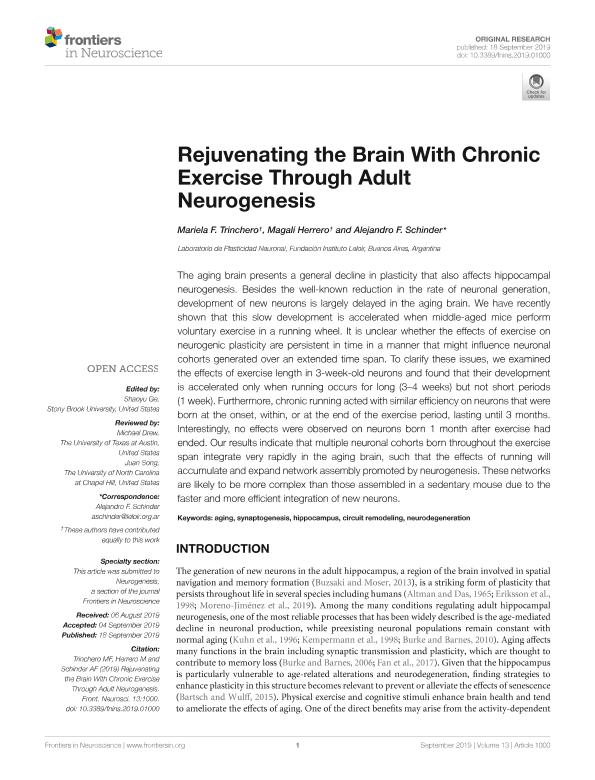Mostrar el registro sencillo del ítem
dc.contributor.author
Trinchero, Mariela Fernanda

dc.contributor.author
Herrero, Magalí

dc.contributor.author
Schinder, Alejandro Fabián

dc.date.available
2021-06-14T14:19:08Z
dc.date.issued
2019-09
dc.identifier.citation
Trinchero, Mariela Fernanda; Herrero, Magalí; Schinder, Alejandro Fabián; Rejuvenating the Brain With Chronic Exercise Through Adult Neurogenesis; Frontiers Media S.A.; Frontiers in Neuroscience; 13; 9-2019; 1-8
dc.identifier.issn
1662-4548
dc.identifier.uri
http://hdl.handle.net/11336/133762
dc.description.abstract
The aging brain presents a general decline in plasticity that also affects hippocampal neurogenesis. Besides the well-known reduction in the rate of neuronal generation, development of new neurons is largely delayed in the aging brain. We have recently shown that this slow development is accelerated when middle-aged mice perform voluntary exercise in a running wheel. It is unclear whether the effects of exercise on neurogenic plasticity are persistent in time in a manner that might influence neuronal cohorts generated over an extended time span. To clarify these issues, we examined the effects of exercise length in 3-week-old neurons and found that their development is accelerated only when running occurs for long (3–4 weeks) but not short periods (1 week). Furthermore, chronic running acted with similar efficiency on neurons that were born at the onset, within, or at the end of the exercise period, lasting until 3 months. Interestingly, no effects were observed on neurons born 1 month after exercise had ended. Our results indicate that multiple neuronal cohorts born throughout the exercise span integrate very rapidly in the aging brain, such that the effects of running will accumulate and expand network assembly promoted by neurogenesis. These networks are likely to be more complex than those assembled in a sedentary mouse due to the faster and more efficient integration of new neurons.
dc.format
application/pdf
dc.language.iso
eng
dc.publisher
Frontiers Media S.A.

dc.rights
info:eu-repo/semantics/openAccess
dc.rights.uri
https://creativecommons.org/licenses/by/2.5/ar/
dc.subject
AGING
dc.subject
CIRCUIT REMODELING
dc.subject
HIPPOCAMPUS
dc.subject
NEURODEGENERATION
dc.subject
SYNAPTOGENESIS
dc.subject.classification
Otras Ciencias Biológicas

dc.subject.classification
Ciencias Biológicas

dc.subject.classification
CIENCIAS NATURALES Y EXACTAS

dc.title
Rejuvenating the Brain With Chronic Exercise Through Adult Neurogenesis
dc.type
info:eu-repo/semantics/article
dc.type
info:ar-repo/semantics/artículo
dc.type
info:eu-repo/semantics/publishedVersion
dc.date.updated
2020-11-18T20:07:55Z
dc.identifier.eissn
1662-453X
dc.journal.volume
13
dc.journal.pagination
1-8
dc.journal.pais
Suiza

dc.journal.ciudad
Lausanne
dc.description.fil
Fil: Trinchero, Mariela Fernanda. Consejo Nacional de Investigaciones Científicas y Técnicas. Oficina de Coordinación Administrativa Parque Centenario. Instituto de Investigaciones Bioquímicas de Buenos Aires. Fundación Instituto Leloir. Instituto de Investigaciones Bioquímicas de Buenos Aires; Argentina
dc.description.fil
Fil: Herrero, Magalí. Consejo Nacional de Investigaciones Científicas y Técnicas. Oficina de Coordinación Administrativa Parque Centenario. Instituto de Investigaciones Bioquímicas de Buenos Aires. Fundación Instituto Leloir. Instituto de Investigaciones Bioquímicas de Buenos Aires; Argentina
dc.description.fil
Fil: Schinder, Alejandro Fabián. Consejo Nacional de Investigaciones Científicas y Técnicas. Oficina de Coordinación Administrativa Parque Centenario. Instituto de Investigaciones Bioquímicas de Buenos Aires. Fundación Instituto Leloir. Instituto de Investigaciones Bioquímicas de Buenos Aires; Argentina
dc.journal.title
Frontiers in Neuroscience
dc.relation.alternativeid
info:eu-repo/semantics/altIdentifier/doi/http://dx.doi.org/10.3389/fnins.2019.01000
dc.relation.alternativeid
info:eu-repo/semantics/altIdentifier/url/https://www.frontiersin.org/articles/10.3389/fnins.2019.01000/full
Archivos asociados
